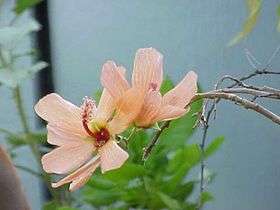Lavatera phoenicea
| Lavatera phoenicea | |
|---|---|
 | |
| Lavatera phoenicea flowers | |
| Scientific classification | |
| Kingdom: | Plantae |
| (unranked): | Angiosperms |
| (unranked): | Eudicots |
| (unranked): | Rosids |
| Order: | Malvales |
| Family: | Malvaceae |
| Genus: | Navaea |
| Species: | N. phoenicea |
| Binomial name | |
| Navaea phoenicea | |
Lavatera phoenicea (syn. Althaea phoenicea Kuntze,[1] Lavatera coccinea Dietr. ex DC and Navaea phoenicea Webb.[2]) is a large shrub belonging to the family Malvaceae and tribe Malveae, endemic to the island of Tenerife in the Canary Islands.
Webb and Berthelot included this plant in the separate, monotypic genus Navaea, named for Alonso de Nava y Grimón, (1757-1832), founder of the botanical garden in Puerto de la Cruz, Tenerife (Jardín de Aclimatación de la Orotava). The reason for including this species in a separate genus was the presence of nectaries in the base of each petal, which is unique in the Malveae tribe. Published studies (and some recent others not published yet) using molecular markers (chloroplast and ITS sequences) support this separation, as phylogenetic trees show L. phoenicea in a basal position in relation to the rest of Lavatera-Malva complex, and thus, as a palaeoendemic taxa.
This plant presents a clear bird pollination syndrome, a phenomenon shared with another 12 Macaronesian endemics (genus Muschia, Lotus, Isoplexis, Canarina, Echium and Scrophularia). This bird pollination syndrome is pretty rare in these latitudes and seems to have independent origins according to phylogenies of each lineage.
L. phoenicea is very rare and it is threatened. It grows only in northern cliffs in the massifs of Anaga and Teno, on Tenerife.
References
| Wikimedia Commons has media related to Lavatera phoenicea. |